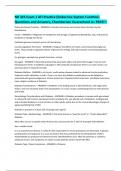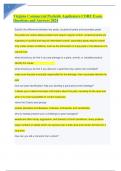NR 325 Exam 1 ATI Practice (Endocrine System Function)
Questions and Answers; Chamberlain Guaranteed A+ PASS!!!
Endocrine System Function - ANSWER>>>Produce hormones and secrete them directly into the
bloodstream
Insulin - ANSWER>>>Regulator of metabolism and storage of ingested carbohydrates, fats, and proteins
(anabolic or storage hormone).
Facilitates glucose transport across cell membranes
Counterregulatory Hormones - ANSWER>>>Oppose the effects of insulin, and increase blood glucose
levels. They provide a regulated release of glucose for energy, and help maintain normal blood glucose
levels.
Ex: glucagon, epinephrine, growth hormone, cortisol
Glucagon - ANSWER>>>Normally produced by pancreatic alpha cells when blood sugar is low to raise
blood glucose levels. In diabetes II, glucagon is still produced, but because there is so much insulin, our
pancreas doesn't respond normally.
Diabetes Mellitus - ANSWER>>>A chronic, multi-system disease related to abnormal insulin production,
impaired insulin utilization, or both. There is no cure, but diabetic complications can be delayed or
prevented with good management. African Americans, Hispanic/Latino Americans, and Native Americans
have a higher incidence of diabetes.
Diabetes Complications - ANSWER>>>Diabetes is the leading cause of adult blindness, end-stage renal
failure, and non-traumatic lower limb amputations. It is also a major contributing factor to heart disease
and stroke.
Gerontologic Considerations with Diabetes - ANSWER>>>Diabetes prevalence increases with age related
to reduced B-cell function, decreased insulin sensitivity (!!), and altered carb metabolism. Undiagnosed
and untreated diabetes is more common in older adults, partly due to the normal physiologic changes of
aging resembling that of DM.
Diabetes is present in at least 25% of people over age 65.
Diabetes Type I Epidemiology - ANSWER>>>Formerly known as "juvenile onset" or "insulin dependent"
diabetes.
Most often occurs in people under 40 years old, and accounts for 5-10% of all people with diabetes.
Has a sudden onset.
It is an autoimmune disease, in which B-cells responsible for insulin production are destroyed. A genetic
predisposition and exposure to a virus are factors that may contribute to the development of DM I.
Autoantibody are produced and destroy B-cells. Manifestations occur after the pancreas is unable to
produced insulin, and symptoms are rapid. Usually patients present to ER with DKA.
Diabetes Type I Classic Symptoms - ANSWER>>>Polyuria
,Polydipsia
Polyphagia
Weight loss
Prediabetes - ANSWER>>>Known as impaired glucose tolerance (IGT) or impaired fasting glucose (IFG).
Prediabetes Labs - ANSWER>>>IFG: fasting glucose levels 100-126 mg/dl
IGT: 2 hour plasma glucose 140-199 mg/dl
A1C: in the range of 5.7-6.4%
A1C Lab - ANSWER>>>It is a test that determines how well your glucose was stabilized within the last
three months.
If you have a high A1C, that means you have had high glucose levels in the last 3 months
Diabetes Type II Etiology - ANSWER>>>Probably has a genetic basis.
A genetic mutation leading to insulin resistance, and as the disease progresses, less insulin production.
There is also an increased risk for obesity.
Obesity is the most powerful risk factor, especially obesity with an increased waist circumference.
Type II DM is now being seen in children due to epidemic of childhood obesity.
Type II accounts for 90% of diabetics.
Pancreas continues to produce insulin, but the body can't use the insulin.
Diabetes Type II Risk Factors - ANSWER>>>Obesity
Aging
Sedentary lifestyle
Family history of Type II DM
Urbanization
Certain ethnicities (AA, NA, Latino)
Diabetes Type II Clinical Manifestations - ANSWER>>>Nonspecific symptoms, may have classic symptoms
of type I
Fatigue
Recurrent infections
Recurrent vaginal yeast or monilia infections
Prolonged wound healing
Visual changes
, The onset of symptoms is gradual.
Diagnosing Diabetes: Fasting Plasma Glucose Level - ANSWER>>>>126 mg/dl
Fasting is no caloric intake for at least 8 hours. The FPG test needs to be confirmed by repeating testing
on another day.
Diagnosing Diabetes: Random Plasma Glucose Measurement - ANSWER>>>>200 mg/dl plus symptoms
Diagnosing Diabetes: Two-Hour OGTT Level - ANSWER>>>>200 mg/dl using a glucose load of 75g.
You have the patient drink a syrup drink and evaluate how well the body tolerates large doses of sugar.
Diagnosing Diabetes: Hemoglobin A1C Test - ANSWER>>>Useful in determining glycemic levels over
time. May be used in diagnosis or to monitor success of treatment. It shows the amount of glucose
attached to hgb molecules over RBC life span (3 months). <6.5-7%
Goal of Diabetes Management - ANSWER>>>Decrease symptoms
Promote well-being
Prevent acute complications
Delay onset and progression of long-term complications
Exogenous Insulin - ANSWER>>>Insulin from an outside source.
Required for type I DM.
Prescribed for patients with DM II who can't control blood glucose by other methods.
Insulins differ in regard to onset, peak action, and duration.
It is given by a subcutaneous injection or IV, never orally.
Regimen that closely mimics endogenous insulin production is basal-bolus.
Basal-Bolus Insulin Therapy - ANSWER>>>Intensive insulin therapy consisting of multiple daily injections
and frequent self-monitoring of blood glucose levels. It is insulin administration that mimics normal
pancreas function.
Rapid-Acting Insulin Onset, Peak, and Duration - ANSWER>>>Ex: lispro (Humalog), aspart (NovoLog),
glulisine (Apidra)
Onset: 10-30 minutes
Peak: 30 minutes- 3 hours
Duration: 3-5 hours
Short-Acting Insulin Onset, Peak, and Duration - ANSWER>>>Ex: regular insulin (Humulin R, Novolin R)
Onset: 30 min - 1 hour
Peak 2-5 hours





